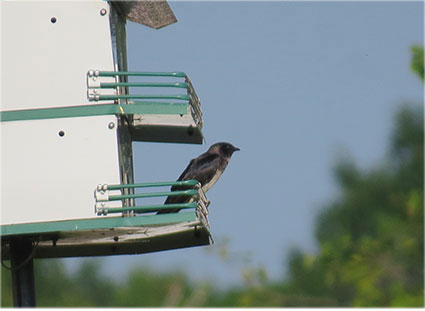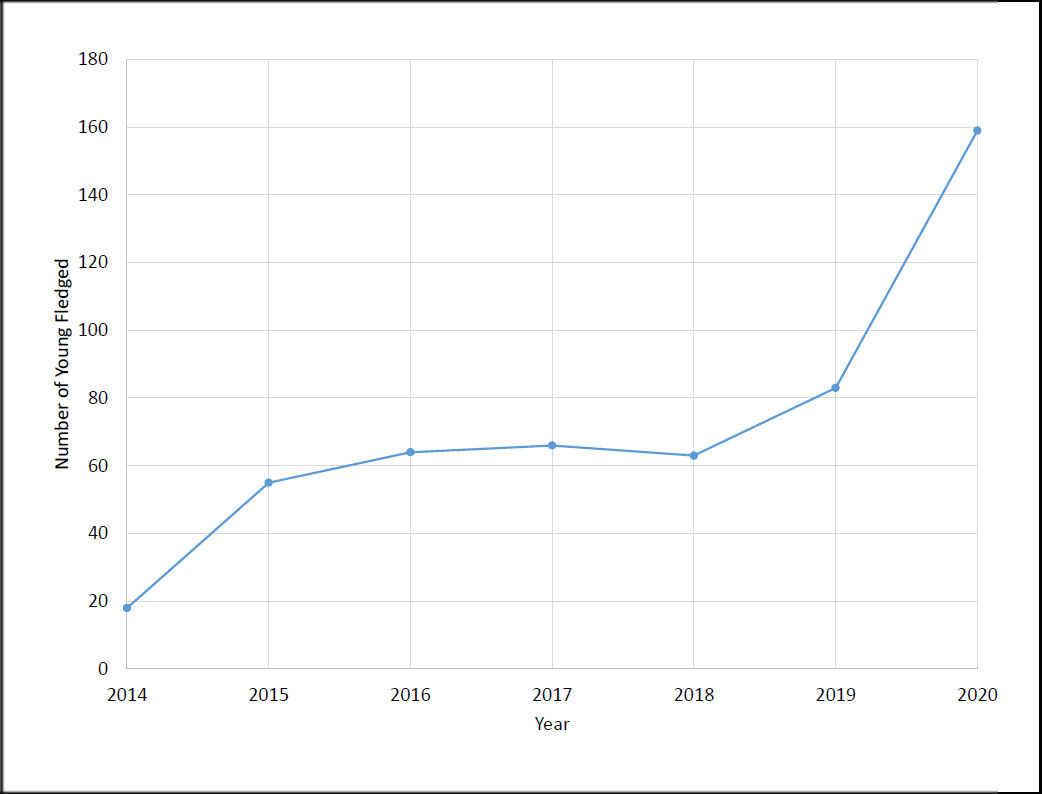Another Record Year for New Hampshire’s Purple Martins

Article by Pam Hunt
Photo: Immature male Purple Martin at the new colony in Rye, NH. Photo by Pam Hunt.
Figure 1 (see bottom of page): Purple Martin productivity in New Hampshire, 2014-2020
We’ve been keeping records on the number of Purple Martin pairs in New Hampshire since the mid-1990s, but comprehensive data on productivity goes back only seven years, to the first time the majority of birds were nesting in easily-monitored gourd arrays. Over the years, two broad patterns have been pretty obvious: a consistent decline in the number of colonies since the 1980s, and a growth in the number of young fledged since 2014. Both of these trends can be largely tied to housing, specifically the increased use of gourd arrays that are easily cleaned and monitored.
Prior to our first gourds going up in Seabrook in 2014, all martins in the state nested in “martin condos,” those ubiquitous multi-holed boxes still scattered across the landscape – and almost entirely unoccupied. While these are perfectly fine places to nest, they have two drawbacks: not being as spacious and not always easy to access to monitor nesting success. Some, like the heavy wooden houses at the Fun Spot, could not even be lowered, so despite this being the largest colony in the state for many years, we rarely had a good idea of how many young were produced.
With the decline of our Lakes Region population through the 2010s (the Fun Spot colony abandoned in 2016, Wakefield in 2017), most martin activity shifted to the Seacoast, where almost all birds were in gourds (the exception being the Portsmouth Country Club, where martins are still off-and-on). Perhaps aided by dispersal from Massachusetts, the coastal population grew quickly, and our two main colonies in Seabrook and Rye are now maxed out with 18 and 16 pairs apiece. With the success of these colonies, we’ve hoped that overflow will establish new ones nearby, and there have been early signs of this in Hampton and Greenland where we’ve had martins investigating gourd arrays.
The arrival of COVID-19 limited how much work we could do in 2020 and efforts in Hampton and Greenland were put on hold. We focused on the two main colonies, but martins aren’t terribly worried about global pandemics, and two pairs managed to find an old martin condo along Old Beach Road in Rye, less than a mile and a half from the colony at Awcomin Marsh. The birds even started using the box when it was only halfway up the pole and infested with House Sparrows! With the help of the landowner, we were able to raise the box, and while systematic monitoring didn’t happen, periodic visits confirmed that at least one of the pairs had young at the end of July. Our plans for this site include a new gourd array on abutting property in 2021, and if the birds return and take a liking to it there’s a good chance we’ll have another success on our hands.
As for this year’s numbers, the 36 known pairs produced at least 159 young (Figure 1, not including the new Rye site), which is double the record set just last year. This is encouraging news that it wouldn’t be possible without a handful of extremely dedicated volunteers. These folks put up the gourds in the spring, make weekly visits to check on status, and evict invasive House Sparrows when needed. New volunteers will be needed as the number of colonies grows. Stay tuned for updates. Purple Martin restoration is supported by private donations.
Figure 1 below: Purple Martin productivity in New Hampshire, 2014-2020
